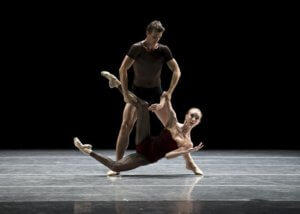
D.M.J. 1953-1977
Until this past Thursday evening, I had never seen the Boston Ballet and suspected the company might be some blue-stockinged poor relation of New York’s acclaimed companies. Not so! My friend Susan and I were blown away by the quality of the dancing, the startlingly original choreography, and the inventive staging.
The program opened with “D.M.J. 1953-1977,” which was created in 2004 and set to music by three Czech composers, Dvorak, Martinu, and Janacek (the D, M, and J of the title). Choreographed by Petr Zuska, the piece opened with the haunting largo section of “New World Symphony.” Roses were suspended against a deep cobalt blue background and the dancers were positioned near large stele-like slabs. These vaguely tomb stone-like pieces (which put both Susan and me in mind of “2001, A Space Odyssey”) moved throughout the performance, allowing dancers to slide on them, sit on them, or be hidden by them. The roses—red hardly seemed a funerary choice, but more an homage to lost love or passion—appeared and disappeared throughout the

D.M.J. 1953-1977
piece. Lyrical and beguiling, the opening section evokes love, loss, and regret.
The mood changes in the middle section—becoming frantic and furious, with dancers moving between the now upright stele with urgency, breathtaking leaps, and an astonishing jump in which a woman leaps into space, parallel to the stage, and is caught in mid-flight, arms reaching straight ahead.

D.M.J. 1953-1977
The final section was stripped, literally, of the flowing white and soft grey costumes. Here, the stunning Lia Cirio and Lasha Khozashvili appear in flesh-colored undergarments, sitting, rolling and collapsing on the slabs like broken puppets. In the end, Cirio greedily gathers up masses of roses, allowing them to fall to her feet, and, holding one against her haunted face, lies upon the slab as the curtain comes down.
In comparison, Balanchine’s “Rubies” seemed, after its first dazzle—a huge sparkly starburst set against the burgundy curtain—a tad musty in comparison. In its day, Balanchine’s choreography was likely sensational (the full piece, “Jewels,” premiered in 1967 and was created to showcase the history of classical dance. “Rubies” demonstrated ballet’s French foundation, “Diamonds” embodied Russia’s imperial style, and “Emeralds,” the new American version.)

Rubies
Susan put it well, “Pretty, but perky.”
The final piece, “Bella Figura,” choreographed by Jiri Kylian, was a standout, although the recorded music (Lukas Foss, Giovanni Battista Pergolesi, Alessandro Marcello, Antonio Vivaldi, and Giuseppe Torelli) was a let-down—all wonderful music, but one missed the orchestra.

Bella Figura
First seen in 1995, the piece opens with the house lights up, the dancers engaging in what appeared to be aimless warming-up on a bare, stripped down stage, in silence. As the house-lights come down and the audience quiets, the opening strains of the music seem to cause the dancers to freeze. The curtain comes down partially to frame a single male dancer to the right of the stage. Clad only in flesh-toned briefs and in an impossible shoulder stand, he writhes with the energy of a butterfly emerging from a cocoon. A female dancer on the left scrabbles forward and backward, uttering a silent scream, as the black curtain embraces her, then  releases her to dash forward again.
releases her to dash forward again.
The choreographer makes each movement so economical, yet so full of brimming emotion, that you’re riveted to the many small stories emerging, collapsing, and flowering again. The overarching emotion is longing—a tender yearning for love and connection, a kind of lamentation. Danced on a dramatically lit bare stage with a molten surface, much of the piece is crisply matched to the music. Sharp arm movements, and flexed feet are balanced by sensuous hip swivels and undulating backs; marvelously inventive slides and percussive slaps climax in an extraordinary lift, in which the woman, caught by the man, falls limp in his arms and, melting onto the floor, walks, lynx-like, on all fours, with the man’s hand resting lightly on her back, as if tethering

Bella Figura
her. Halfway-across the stage, they switch, he on all fours, she resting a hand on his back.

Bella Figura
The appearance of a crimson-skirted, bare-chested woman is as startling as one of the male dancers crash-landing on the stage at a particularly percussive moment in the score. The duet which follows has it all: percussive hand and foot movements, off-kilter flexed feet, even a vampire bite. Soon our herky-jerky duo are banished from the stage by a majestic line of the red-skirted women, who stand, arms extended at the elbows, to catch the

Bella Figura
descending curtain, then fling it over their heads. Evocative of Balinese dancers crossed with Samuri warriors, bare-chested men join the procession. At the close of this ravishing section, two women approach the curtain, and leaning into it, swoon onto the stage repeatedly—another of the inventive uses of the curtain as prop, or as a seemingly living part of the dance. In the end, they shed their skirts, leaving them bunched at their feet as their bodies wave like sea anemones, blown this way and that by unseen currents.

Bella Figura
In the final section, two couples are flanked by flaming sconces. When the haunting vocal solo ends, you can hear the muffled sound of the flames as the dance continues in silence, ending with a touching sequence in which the male dancer, his face stricken, gently moves the raised shoulder of his partner down, and she returns the gesture, as if soothing the anxiety out of the other’s body. And so it ends.
See Bella Figura here, in full: https://www.youtube.com/watch?v=UFg8DUjEH0o













